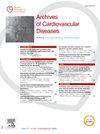出生后早期过量喂养对幼鼠心脏成分和代谢的影响
IF 2.3
3区 医学
Q2 CARDIAC & CARDIOVASCULAR SYSTEMS
引用次数: 0
摘要
出生后不久,心脏代谢从以无氧糖酵解为主要能量来源转变为主要依靠脂肪酸β-氧化。同时,心肌细胞失去了向肥厚生长转变的增殖能力,但代谢底物的可用性和利用的变化影响了这一出生后的增殖窗口期。啮齿动物产仔数减少引起的产后过度喂养(PNOF)模拟了童年营养过度的影响。目的探讨PNOF幼鼠出生后心脏增殖及早期脂质改变。方法将c57bl /6雄性幼鼠分别饲养在9只或3只窝中,形成正常喂养组(NF)和产后过量喂养组(PNOF)。在出生后7、10和24天(分别为PN7、PN10和PN24)收集心脏,对增殖标志物Ki67进行免疫染色。采用液相色谱联用质谱法对PN7幼崽的心脏组织和血浆以及喂养PN7幼崽的母鼠的乳汁进行脂质组学分析。最后对PN7和PN24心脏马拉塞兹计数室进行心肌细胞计数。结果在所有时间点,与NF对照组相比,nof幼鼠的体重和心脏质量均显著增加。PN7乳中总脂肪酸(FA),包括饱和长链脂肪酸和鞘磷脂均有所增加。在PN7时,在循环脂肪酸保持不变的情况下,PNOF幼犬心脏的心磷脂和脂肪酸含量显著降低。血浆和心脏组织中的脂质过氧化产物,包括氧甾醇、HODE和HETE,也减少了。在PN7时,心肌细胞增殖率显著降低,并与心肌细胞表面增加相关。最后,在PN7和PN24, PNOF小鼠中观察到每毫克组织心肌细胞数量的减少。结论出生后不久,产仔数的减少引起了PNOF新生儿血脂组成的显著变化,从而引起了心脏和血浆脂质的变化。PNOF还与心肌细胞增殖改变和心肌细胞肥大有关。需要进一步的研究来确定这些脂质和心脏变化是否有因果关系,并阐明它们之间关系的机制。本文章由计算机程序翻译,如有差异,请以英文原文为准。
Early postnatal overfeeding influence on cardiac composition and metabolism in juvenile mice
Introduction
Shortly after birth, the cardiac metabolism shifts from anaerobic glycolysis as the main energy source to predominantly relying on fatty acid β-oxidation. Concomitantly, cardiomyocytes lose their ability to proliferate to switch towards a hypertrophic growth, but variations in the availability and utilization of metabolic substrates influences this postnatal proliferative window. Postnatal overfeeding (PNOF) induced by litter size reduction in rodents mimics the effects of childhood over nutrition.
Objective
The aim of this study was to investigate postnatal cardiac proliferation and early lipid modifications in PNOF juvenile mice.
Method
C57BL/6 male pups were raised in litters adjusted to either 9 or 3 pups to form normally fed (NF) or postnatally overfed (PNOF) group, respectively. Hearts were collected at 7, 10, and 24 days post-birth (PN7, PN10, and PN24, respectively) for immunostaining of the proliferation marker Ki67. Lipidomic analyses were performed using liquid chromatography coupled with mass spectrometry on cardiac tissue and plasma from PN7 pups, as well as on milk from dams nursing PN7 pups. Finally, cardiomyocyte number was evaluated on Malassez counting chamber in PN7 and PN24 hearts.
Results
PNOF pups exhibited significantly higher body weight and cardiac mass compared to NF controls at all time points. An increase in total fatty acids (FA), including saturated long-chain FA and sphingomyelin, was observed in the milk of PN7 dams. At PN7, while circulating fatty acids remained unchanged, cardiolipin and fatty acid contents were significantly decreased in the hearts of PNOF pups. Lipid peroxidation products including oxysterols, HODE and HETE, were also reduced in both plasma and cardiac tissue. At PN7, cardiomyocyte proliferation rate was significantly reduced and associated with an increase in cardiomyocyte surface. Finally, at both PN7 and PN24, a reduction of cardiomyocyte number per milligram of tissue was observed in PNOF mice.
Conclusion
Shortly after birth, the reduction of litter size induces significant changes in milk lipid composition and, consequently, cardiac and plasma lipid changes in PNOF new-borns. PNOF is also associated with cardiomyocyte proliferation changes and cardiomyocyte hypertrophy. Additional investigations are required to determine whether these lipid and cardiac changes are causally linked and to elucidate the mechanisms underlying their relationship.
求助全文
通过发布文献求助,成功后即可免费获取论文全文。
去求助
来源期刊

Archives of Cardiovascular Diseases
医学-心血管系统
CiteScore
4.40
自引率
6.70%
发文量
87
审稿时长
34 days
期刊介绍:
The Journal publishes original peer-reviewed clinical and research articles, epidemiological studies, new methodological clinical approaches, review articles and editorials. Topics covered include coronary artery and valve diseases, interventional and pediatric cardiology, cardiovascular surgery, cardiomyopathy and heart failure, arrhythmias and stimulation, cardiovascular imaging, vascular medicine and hypertension, epidemiology and risk factors, and large multicenter studies. Archives of Cardiovascular Diseases also publishes abstracts of papers presented at the annual sessions of the Journées Européennes de la Société Française de Cardiologie and the guidelines edited by the French Society of Cardiology.
 求助内容:
求助内容: 应助结果提醒方式:
应助结果提醒方式:


